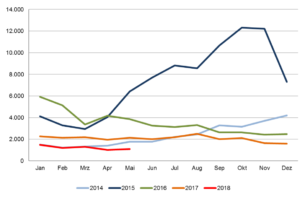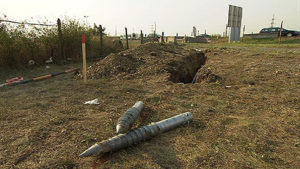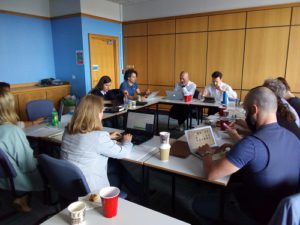By Johanna Elle (Georg-August Universität Göttingen) and Sabine Hess (Georg-August Universität Göttingen).
Since summer 2015, there have been a number of remarkable shifts in gender awareness in the context of flight and migration in the German refugee debate. The attention paid to gender-specific issues in the press and politics soared quite abruptly in 2015 so that we gender researchers with longstanding experience could not believe our eyes. Up and down the country, the major newspapers asked questions such as “Where are all the mothers and daughters from the crisis areas?” (Spiegel Online, 9 September 2015) and “Why do the photos show only young men?” (Stuttgarter Zeitung, 10 September 2015). They tried to find answers: As early as July 2015, a headline explained “Why asylum seekers are predominantly male” (Süddeutsche Zeitung 27 July 2015). When the women were finally “found”, most reports agreed that women and children were especially vulnerable and subject to violence – particularly sexualised, gender-based violence – to an above average extent in their countries of origin, along the migration route and in the country of destination. From then on, the “protection gap” topos (Süddeutsche Zeitung, 14 January 2016) dominated the discourse about the particular challenges that confront female refugees, also in the context of their reception. Although we gender researchers welcomed this shift in the beginning as a belated acknowledgment of the centrality of gender as a structural category for the field of migration and flight, we quickly had to recognise that this new gender awareness came along with a series of shortcomings, side- and boomerang effects. In the following chapters, we will therefore roughly outline how these discourses were structured and point to some of the side effects and pitfalls we observed based on an on-going ethnographic research project on “gender in reception policies and the politics of arrival”.
How gender enters the refugee debate – a short genealogy
Since summer 2015, some of the discussions held and reports published have indeed attempted to outline the complexity of gender-specific root causes for flight as well as gender-specific challenges upon arrival. Many, however, have remained superficial, not only producing a highly binary interpretation of gender policy, but also introducing a reductive approach to the problem that has had far-reaching consequences. On the one hand, this type of reporting represented female refugees primarily as vulnerable and passive actors in need of protection, and narrowed the problem of being systematically exposed to violence down to predominantly sexualised and interpersonal violence. This soon turned smugglers and male refugees who were fleeing with them into the biggest threat, and not, for instance, the militarised border apparatus and the violence of border patrols. At the same time, the articles introduced the figure of the “dangerous unaccompanied male refugee” who is posing a danger to “German society” in general. Many months before the incidents in Cologne on New Year’s Eve, sociologist Armin Nassehi already warned against a “masculinisation of the public space” as a consequence of the arrival of mainly young male refugees (Die Welt, 5 October 2015).
The events in Cologne on that New Year’s Eve irreversibly corroborated the new threat and contributed to a change in the societal attitude towards refugee movements. In the guise of sexism complaints, Cologne and the subsequent heated discourse on dealing with what happened there revealed a potential for articulating racism that had not been known before (Dietze 2016). It was also in this volatile climate that Kai Wegner, a Member of the German Bundestag from Berlin from the conservative CDU party, published his proposal in February 2017 to introduce a quota regulation for refugees, this time arguing in favour of women: male refugees were to be turned back at the borders once a certain quota had been reached. The conservative MP claimed that in doing so, a “balance” and “peaceful coexistence” could be maintained, while women and children as “persons in need of protection” would still find refuge (Berlin CDU MP Kai Wegner, 10 March 2017). Wegner thus took up the gender argument, as many others have in recent years, to restrict the migration of refugees to Germany.
This increased public debate on the particular challenges and the protection needs of “women and children” – usually mentioned in the same breath – was well-received politically, particularly by actors in the field of gender equality; also here, it led to a new focus on the specific interests and needs of this group of women. Concepts for protection against violence were drafted at the national, regional and municipal levels, referencing international agreements. Numerous integration projects were also put in place that are tailored to refugee women in emergency situations as we will show in more detail in the second part of this article.
Since 2017, another discursive shift has become noticeable: while the flight paths were more or less cut off due to the closure of the Balkan route and the so-called EU-Turkey and Italy-Libya deals (Hess/Kasparek 2018), and international media shifted their attention to other regions of the world, the refugee debate in Germany has increasingly been framed as a debate on integration and deportation. Also here, gender relations, especially the topos of gender equality, have gained a prominent position on the agenda for measuring ostensible integration progresses and stumbling blocks. Programmes concerned with integration have thus increasingly become a “task” for gender equality actors. Against the backdrop of the threat of forced deportations, the “integration imperative” (Hess/Moser 2009) is now gaining essential governmental significance in regulating the migration of refugees, where refugee women are not only addressed as a group in need of protection but are ascribed a special role in integration efforts.
The following section will shed light on how gender is articulated in reference to discourses on protection and integration as the main discursive threads in the field of gendered reception policies. What (culturalised) gender models are invoked and/or reproduced by what effect? What impact does this have on local practices?
Protection measures – or: the policy of minimum standards
A “feminist boom” as regards the protection needs of refugee women in accommodation centres can be observed not only in media discussions but also at the policy level (see Neuhauser/ Hess/ Schwenken 2016). The Institute for Human Rights issued a warning in 2015: “Especially the protection against gender-specific violence and sexual harassment in accommodation centres is hardly being addressed at the moment. This particularly affects vulnerable groups of refugees, such as women, who make up about one third of the asylum seekers, and gay, bisexual, trans* and inter* people (LGBTI).” (Rabe 2015: 3). Internationally, the topic of protection (against violence) in providing care and accommodation for refugees has been playing a role for more than 20 years. Besides a multitude of guidelines from the UNHCR and other NGOs, agreements such as the so-called Istanbul Convention and the EU’s Reception Directive, which was intended to be transposed into national legislation by 2015, are cases in point. In Germany, however, there has been practically no movement in this regard in the past few years. With the exception of including gender-based flight causes in the asylum recognition procedure with the amendment of the Immigration Act in 2004, nothing significant has been undertaken concerning this problem by either the state or by large welfare associations.
Since 2016, however, numerous concepts, guidelines and demands have emerged at all levels authored by a variety of players, which make the field of refugee reception a highly dynamic field, also in terms of gender policy. The federal protection-concept, published in 2017 in its second revised edition with the title “Minimum standards for the protection of refugees in accommodation centres”, shows an especially differentiated approach. In their conceptualization, the authors – the Federal Ministry for Family Affairs, Senior Citizens, Women and Youth, UNICEF and a number of other welfare associations and feminist NGOs – focus not only on the aspect of interpersonal violence; their package of measures rather primarily addresses structural shortcomings and problems in accommodation centres and the welfare system. Its pillars include an in-house protection concept, personnel management in each facility, as well as taking into consideration architectural, social work and general legalconditions that foster human dignity, protection and support. Unfortunately, the comprehensive and carefully written paper remains at the recommendation level with about 100 pilot projects, as it was apparently not possible to find consensus for including “the minimum standards” in one of the many legal revisions of the asylum and integration regime of the last two years.
This shortcoming in the legal foundation is typical of all these protection concepts formulated as “minimum standards” for decent and safe accommodation of refugees in Germany. A great number of analyses of provisions for reception and accommodation at the national, regional and municipal levels fundamentally point out a considerable under-definition of legal and structural conditions and a lack of legally binding regulations, which are the predominant reasons behind the existing unsatisfactory safety situation in accommodation centres. Our survey “Life beyond minimum standards. A documentation of the situation in asylum seeker accommodation centres in Lower Saxony” (Elle/Hess 2018) also shows that, notwithstanding international agreements, there is an enormous discrepancy between concept and administration on the one hand and practical implementation on the other, because to date there is still no legally binding political, legal and financial framing whatsoever. Our study reveals, for instance, that this affects very basic conditions such as clean washrooms, sufficient living space and conflict-preventing and flexible accommodation practices oriented towards the needs of the refugees, as well as access to information to enable arriving and starting a new life in exile in a dignified manner. The numerous newly designed programmes, in contrast, with their often narrow focus on “particularly vulnerable” people, such as women travelling alone (with their children) and their specific problems, thus often change accordingly little in the general reality of the lives of refugees. Conversely, such special programmes turn into a tiny “band-aid” for a large problem. In addition, their orientation towards “protection” and their focus on vulnerability instead of the strength of these refugee women who made their way to Germany, also encourages a victimising, paternalistic line of argument expressed in the consensus to want to “save” these refugee women. The anthropologist and researcher in the field of humanitarianism, Miriam Ticktin (2011), asks in her analysis of the “politics of care”: “What does ‘doing good’ actually end up doing?” This is exactly the question that one can currently ask in view of the very basic problems that refugees are continuously reporting: the constricted space, the inadequate hygienic conditions, the lack of a private sphere or of appropriate rooms to retreat as well as the absence of any gender-sensitive architecture, as well as very basic separate facilities for men and women in many of the mass accommodation centres. Refugee councils and welfare associations have been calling for nation-wide legally binding and sustainable regulations and reception concepts for many years, but they have not been heard.
There is an ambivalence between a very necessary protection (against all kinds of structural and personal forms of violence) and the symbolic “band-aid” function which can be the fate of violence protection measures in the face of the highly-problematic basic structures of reception and accommodation policies. As our research demonstrates, violence protection measures are used by municipal actors to award mass accommodation centres – notwithstanding their structural production of deprivation, dependency and uncertainty as very fertile grounds for violence – a “certificate of good standing”. Our research also shows that the access to protection, care and better housing does not constitute a universal right for all refugee women as “persons in need of protection”. Rather, these kinds of special programmes and protection measures are often only accessible for refugees “with a good prospect to stay”. This new category has mainly been introduced to exclude all other refugee groups from certain social and integration measures from the very beginning. In this respect, also special women programmes turn out to be another tool for practicing differential inclusions within German society (Mezzadra/Neilson 2013) – or put differently: an intentional withdrawal of protection is politically intended to increase the refugees’ willingness to return to their countries of origin.
This point leads us to our second thread, the integration discourse as yet another policy field of gender-specific action. Decent and safe housing – and living for that matter – can be considered a vital foundation for arriving and integrating into a society. In this respect, “integration”, as we understand it, is about being given opportunities and rights to participate; but instead, in practice a rather repressive integration/deportation-complex has been emerging in the last two years.
Equality and integration imperative
After a phase that has been commonly regarded as an “emergency situation” or a “crisis” concerned with “saving people”, in 2017 (also in the run-up to the general elections) Germany is increasingly returning to containing and controlling the “consequences of the refugee crisis”. In this context, a “hectic integrationism” can be observed at the national, regional and municipal levels, which entails integrationist programmes and policies that are explicitly addressing refugee women in a highly special manner. There are integration and language programmes designed for them, but these women are also to be trained in “gender competences”, as if this was a “traditional element of German culture”. In the name of “integration”, refugee women are requested to attend language courses, to have strangers look after their children, and, where possible, to integrate themselves into the labour market immediately, while, at the same time, ensuring that their entire family is “integrating” as well.
During these efforts, terms such as “our society”, “our values”, and “our Leitkultur” (see for instance (De Maiziere in Zeit Online 30 April 2017,) are increasingly also finding their way into political discussions of actors aiming at gender equality. In their new book “Differentiating and Conquering”, the two gender researchers Sabine Hark and Paula-Irene Villa show how the emphasis on “our liberal, egalitarian, western consensus” is structuring the asylum discourse of all the different political camps (Hark/Villa 2017: 10). The topic of “gender equality” is experiencing a particular boom in the context of integration policy. Especially the repressive integration/deportation-complex ascribes a central role to this theme to determine integration deficits or to draw ethno-culturalist differentiating lines between us and them with the astonishing effect that even the new right-wing populist party “Alternative for Germany” appears as a gender equality actor par excellence.
However, this is not a new phenomenon. Various scholars have been describing the difficult relationship between feminism and anti-racism time and again. It has a long tradition, and referring to women’s political demands and gender equality already took place in colonial contexts; Colonialism legitimised itself by claiming to set out to rescue “the women of the South” from their backwardness and patriarchal cultures (Mohanty 2003; Castro Varela/ Dhawan 2016). This not only had the welcoming effect that western societies could deem themselves emancipated, but also had the consequence that western feminists enthusiastically joined the colonial project. This colonial project is echoed in the discourses and policies established in the field of “integration”. Even today, the relationship between those who help and speak and those who are helped and seldomly heard follows this international asymmetry. Therefore sensitivity in gender equality policy-making is required to avoid being used as agents in the “feminist disciplining of the migrant subject” (Erdem 2009: 194).
Bibliography
Castro Varela, M./Dhawan, N. (2016): Die Migrantin retten. Zum vertrackten Verhältnis von Geschlechtergewalt, Rassismus und Handlungsmacht. In: Österreichische Zeitschrift für Soziologie, 41 , S. 13-28
Dietze, Gabriele (2016): Das ‚Ereignis Köln‘, Femina Politica, 1, S. 93-102, https://doi.org/10.3224/feminapolitica.v25i1.23412
Elle, Johanna/Hess, Sabine (2018): Leben jenseits von Mindeststandards. Dokumentation zur Situation in Gemeinschaftsunterkünften in Niedersachsen. Im Auftrag des Rats für Migration. https://www.gender-flucht.uni-osnabrueck.de/fileadmin/MWK-Projekt/Publikationen/Jenseits_von_Mindeststandards_Final.pdf
Hark, Sabine / Villa(2017): Unterscheiden und Herrschen. Bielfeld: transcript.
Hess, Sabine/ Neuhauser, Johanna and Helen Schwenken (2017): Wie lässt sich genderanalytisch auf Geschlecht und Flucht blicken? Skizze eines Forschungsprogramms. In: Onnen, Corinna/Rode-Breymann, Susanne (Hrsg.): Zum Selbstverständnis der Gender Studies. Methoden – Methodologien – theoretische Diskussionen und empirische Übersetzungen. Barbara Budrich: Opladen/Berlin, S. 71-88
Hess, Sabine/ Kasparek Bernd (2017): De- and Restabilising Schengen. The European Border Regime After the Summer of Migration. In: Cuadernos Europeos de Deusto: Governing Mobility in Europe: Interdisciplinary Perspectives, 56 , S. 47-78, http://ced.revistas.deusto.es/issue/view/196
Hess, Sabine/ Moser, Johannes (2009): Jenseits der Integration. Kulturwissenschaftliche Betrachtungen einer Debatte. In: Sabine Hess / Jana Binder / Johannes Moser (Hg.): No integration?! Kulturwissenschaftliche Beiträge zur Integrationsdebatte in Europa. Transcript: Bielefeld, S.11-26
Mezzadra, Sando/ Neilson, Brett (2013): Border as Method, or, the Multiplication of Labor. Duke University Press. Durham
Mohanty, Chandra Talpade (2003). Feminism Without Borders: Decolonizing Theory, Practicing Solidarity, Duke University Press Books, Durham.. ISBN 978-0822330219
Rabe,Heike (2015): Policy Paper Nr. 32: Effektiver Schutz vor geschlechtsspezifischer Gewalt – auch in Flüchtlingsunterkünften. Berlin: Institut für Menschenrechte. ISBN: 978-3-945139-71-4.



 My journey to RESPOND began in 2014, when I attended a conference, ‘From a Cradle of Civilization to a Globalizing Transit Region’ organized by the Swedish Research Institute in Istanbul. With a group of academics and researchers from different disciplines like ethnology, psychology, archeology, political sciences, law and linguistics we discussed Turkey in the context of being a transit region witnessing an exchange of people, art and ideas. In fact, this process should be considered as including migration, since the latter is not only about the movement of people, but also about all of the things that people cannot live without. Somehow, big politics frequently narrows migration to literal, dictionary understandings and creates and imposes this image of the process for the public. As a result, we face a production and reproduction of migration discourses, which often diverge from the real picture of the process.
My journey to RESPOND began in 2014, when I attended a conference, ‘From a Cradle of Civilization to a Globalizing Transit Region’ organized by the Swedish Research Institute in Istanbul. With a group of academics and researchers from different disciplines like ethnology, psychology, archeology, political sciences, law and linguistics we discussed Turkey in the context of being a transit region witnessing an exchange of people, art and ideas. In fact, this process should be considered as including migration, since the latter is not only about the movement of people, but also about all of the things that people cannot live without. Somehow, big politics frequently narrows migration to literal, dictionary understandings and creates and imposes this image of the process for the public. As a result, we face a production and reproduction of migration discourses, which often diverge from the real picture of the process.
 By Susan Beth Rottmann (Özyeğin University)
By Susan Beth Rottmann (Özyeğin University)